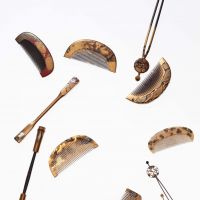Kushi (combs), kanzashi and kōgai (types of hairpins) are three key accessories that Japanese women traditionally wore to decorate their hair. After the Edo Period (1603-1867), these three items became even more popular as young women began to loop and tie their hair into the then-fashionable mage style.
Maki-e, a lacquerware technique that originated during the Heian Period (794-1191), became a popular way to embellish such accessories with colorful designs in gold, silver and other metals. Besides the exquisite art of the Maki-e pieces, this exhibition showcases other beauty-related artifacts, including Japanese bindai vanity tables; till Oct. 1.
Zohiko Urushi Museum; (075) 752 7790; 10 Saishoji-cho, Okazaki, Sakyo-ku, Kyoto; Higashiyama Station, Tozai Line. 10 a.m.-5 p.m. ¥ 300. Closed Wed. www.zohiko.co.jp/museum/en.


















With your current subscription plan you can comment on stories. However, before writing your first comment, please create a display name in the Profile section of your subscriber account page.